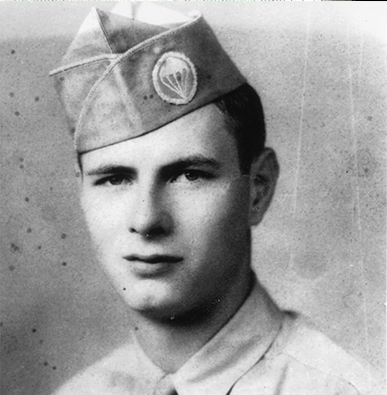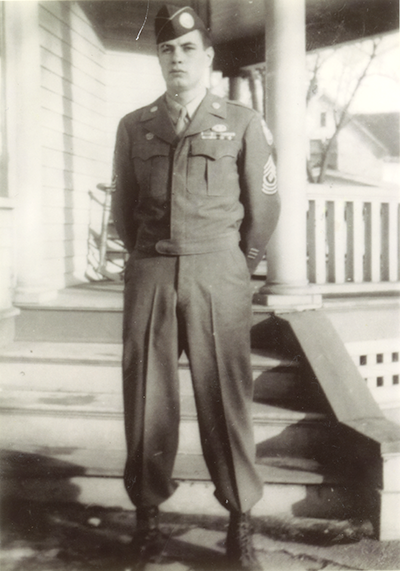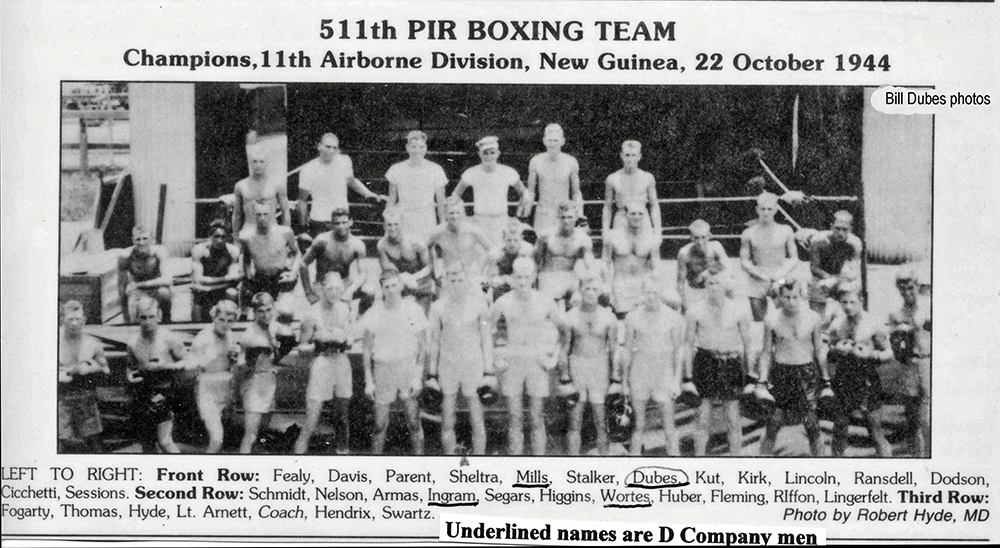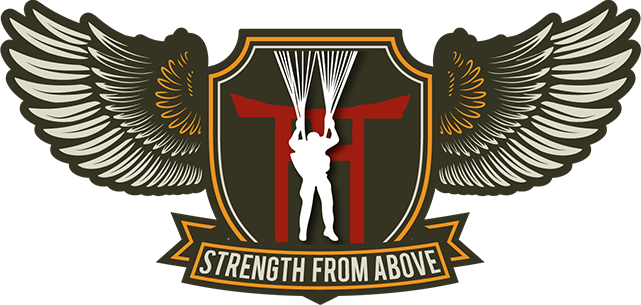Sgt. Dubes, William L.

Company D, 511th PIR
October 11, 1923 - Jan 30, 2012 (Age 88) - obituary
Citations: Purple Heart, Bronze Star, Presidential Unit Citation, Combat Infantryman’s Badge, World War II Victory Medal, Philippine Presidential Unit Citation Badge, Philippine Liberation Medal with bronze star device, the American Defense Medal, and the Asiatic-Pacific Campaign Medal with three Battle Stars and one Arrowhead
Unit Nickname: "Whisky Bill"
I was born in Sioux City, Iowa 10-11-23 and raised in Iowa and South Dakota, in a middle -class, Midwestern family, with one younger sister. When war broke out, I was a freshman at a local college. Pearl Harbor changed everything: My interest in education disappeared, but my attempts to enlist in the Navy and the Marines were thwarted by my Dad’s refusal to sign an 18-year old’s enlistmen papers. He finally relented in the fall of 1941, when the Government said they were going to start drafting 19-year olds. I volunteered for induction into the Army, and after a short wait, was ordered to report to Ft Snelling, Minnesota, and was given the opportunity to volunteer as a paratrooper.
This decision had been on my mind since I talked to a former Jr. High School coach on furlough from the 82nd Airborne.
 I was greatly impressed and thought this would be a great adventure. About a dozen of we “airborne volunteers” shipped out of Ft Snelling in January 1943 to Camp Toccoa, Georgia where we began our training in the Georgia mud.
I was greatly impressed and thought this would be a great adventure. About a dozen of we “airborne volunteers” shipped out of Ft Snelling in January 1943 to Camp Toccoa, Georgia where we began our training in the Georgia mud.
I don’t recall just how long we toiled in Toccoa and Mt. Currhee, but I was happy when we left for Camp Mackall, North Carolina where we completed basic training. Unlike many parachute volunteers, we went to Jump School at Ft Benning as a unit, and a regiment, and we had been physically and mentally prepared for our task. The preliminary stuff such as a “Mock Tower”, controlled chute descent, chute packing, etc. was relatively easy. The jumping itself was the worry. As for me, just to go up in a plane was a “first”, let along being shoved out with a parachute! In spite of some nervous apprehension, I think very few of out men doubted they would jump successfully. Personally, I always enjoyed our jumps. It was the stuff on the ground afterwards that was less rewarding!
After close to 60 years, my recollection of events is limited, especially regarding dates and details. There are periods of time I cannot account for at all.
To continue, back to Camp Mackall after Jump School for more training and simulated problems. Sometime that fall, the Division moved to Camp Polk, Louisiana for more training and maneuvers in the swamps.
I recall getting a furlough home – probably in February - and hunting pheasants in the snow. Shortly after, we rode the train to Camp Stoneman (in November 1944) for debarkation to the Pacific. The most memorable development in our short stay at Stoneman was when all of Company D was put on KP in the huge mess hall and Bittorie clogged up the “China Clipper” in the kitchen and the hot steam kept about 500 hungry men from getting their grub on time. The trip from San Francisco Bay to Oro Bay, New Guinea took the better part of a month, due to constant changing of the ship’s course. This was considered necessary because we had no escort to protect us from submarines. I never would have made a good sailor, as I was queasy most of the trip. This area was to be our training and staging area for the Philippines campaigns, and our first taste of tropical climate. We were told to ditch the perimeter of the pyramidal tents to keep from flooding. Most of us dug a ditch about a foot wide and the same dept, and when the rains hit we were completely inundated. We stayed here several months before heading to Leyte. We had a couple of practice jumps and simulated problems, but still had time for some recreation. I was on the Regimental boxing team, and eventually got my nose rearranged for my efforts.

It was here in New Guinea that the 511th gained the well-deserved “band of thieves” reputation for making regular raids on the food supplies of the Aussie’s camps, as much of the rations we were given originated in Australia. Australian mutton (goat, I called it) was inedible and their butter was move like Mobile Grease No. 2. Aussie canned goods were a great substitute, and much sweeter when confiscated.
It was early November (1944) when we finally shipped out to Leyte in the Philippines and got into the war. To the dismay of many, we were committed as regular infantry. Landings by other troops had been successfully accomplished, and we were to take over and push on across the Island. Rain, mud, mountains, jungle, hunger, malaria, and Japs – are what I remember about Leyte. The rainy season and the terrain made a difficult task much harder. One of the most successful developments was “D” Company’s night attach and “Rats Ass” Charge. The first and second squads of the 1st platoon were the point of this surprise attack in rain and darkness. I think the frustration and pent up anger of the many days of hardship and siege set off this charge on the enemy position. The grenade barrage, screaming and yelling caught the Japs off guard. John Bittorie, with his hand-held machine gun, was probably the catalyst, as we overran the enemy position.
I don’t know how many Japs were killed that day, but we shot everything in sight. I had been coming down with what was later diagnosed as malaria or black-water fever or a day or so before and desperately didn’t want to be left behind in those mountains. I remember the ferocity of the attack, falling down a few times, and eventually being carried down the mountain on a stretcher after we had prevailed.
A short time later, I was about as sick as I have ever been. From a field hospital near Ormac, I was put on a hospital sip and wound up in a larger hospital in Hollandia, New Guinea. Recuperation was made a lot more palatable by the company of three other 1st platooners: Dave Vaughn, Murray Hale, and Hank Olbrych. Vaughn, Hale and myself were soon marked fit for duty, but Olbrych had enough nerve damage that he was sent stateside. We were released and told to report to the Replacement Depot on that base. Rumor had it that the Replacement Depot would send you out as a replacement to any outfit that needed help, but you could get stuck in Hollandia for quite awhile. We wanted to get back to our own outfit as soon as possible, and decided to get there on our own. We headed for the airstrips – looking for transports headed north. I was really surprised at how easy it was to hitchhike a plane ride to our outfit – no questions asked. Most of the planes we rode in were C-47’s or C-46’s, so we were right at home. As I remember, we hopped from Hollandia to Biak, Pelelieu, Mindoro, to Luzon. We gained some information at each stop about the whereabouts of the 11th Airborne and the 511th PIR. We caught up with our regiment and Company D somewhere south of Manila, and unbelievably, Murray Hale became a casualty once again within a few days of his reunion. Since we left, the unit had returned to the eastern side of Leyte, the Mindoro move and the jump on Tagaytay Ridge, and was on the drive to Manila – with the loss of a lot of good men. But it didn’t take long to know that the war was still on. In my recollection, the next vivid development was the Mt. Bijang attack, where D Company was ordered to assault this Japanese-held high ground after a couple of previous attempts had failed. Shortly after my return to the company, Lt. Carrico (previously 1st platoon leader and now Company executive Officer), made me the 1st squad leader. We had many replacements and no time to get to know each other, so the situation was not ideal, but it rarely is, I guess. This was a company strength operation and the 1st platoon was the lead and my squad the point.
Lt. Osmun, the new platoon leader, told me to tell our scouts to stay away from the ravines, as they were probably targeted for possible mortar or artillery patterns. I had two scouts out, and we had advanced almost half way up the slope before encountering enemy fire. A machine gun opened up on the lead scouts. I saw the second scout, “Red” Cegiacnik, go down, and the first scout (I cannot remember his name) disappeared from sight. Then, the gunner fired at me. I rolled over and ate a little dirt, and I think they thought they hit me, as they fired again at Cegiacnik. I thought about getting up and pulling back, but let it go when our artillery opened up. Some of their rounds seemed awfully close to us. I was surprised to see “Red” come staggering back towards me, and the shells were still going off in front of me. I got up and tried to help Cegiacnik. He was in bad shape, and it was a miracle he was on his feet. The machine gun burst had torn away his lower jawbone, his tongue was handing out, and he was bleeding profusely. I was covered in blood just trying to save him. Our medics tried to save him, but he had lost too much blood. The first scout had retreated down a ravine and was okay. The Company Commander then decided to move the point of attack in a different direction, with the 2nd and 3rd platoon moving forward. Evidently, the Japs had pulled back, and the company was able to move almost to the top of the objective without any real resistance. We didn’t have much time to enjoy our luck before the Japs mounted a ferocious counter attack. We could hear them shouting and yelling, working themselves up before the attack. A fire had started, whether intentional or not, the smoke and ashes complicated the situation. It’s hard to know how many casualties we inflicted on them, but they hit a lot of us with mortar fire and rifle and machine gun fire. I was right next to Lt. Osmun when he caught a rifle slug in the left eye that exited in front of his left ear and several others were hit. I was luckier than many, a piece of mortar shrapnel hit my left shoulder, cutting the strap on my harness and ripping the top of my mussette bag. I lost some hide, but nothing too serious. We had taken too many casualties, including CO Cavanaugh and Exec. Officer Carrico, and the decision was made to withdraw. I was not unhappy to comply with the order. My wound was not gravely serious, and one of our replacement medic’s (Doc…………?) send me to the aid station, were they patched me up, gave me shots, and back to duty. I understand that the Regiment sent two companies up Bijiang a few days later, and the Japs had abandoned their positions. This, I think was the last major fire fight that Company D had. We had some mopping up in the Malepunyo Mountains and patrols in response to alleged Jap activities, but that was about all.
With the war ending in Europe, speculation and rumors about the 11th Airborne Division’s role in the up-coming invasion of Japan proper were rampant. The atomic bombs dropped on Hiroshima and Nagasaki put an end to all that. A tragic place accident during our move to Okinawa killed several more Company D troops needlessly. We ended up going into Japan without a struggle, settling down in the small fishing village of Morioka, housed in a former merchant marine training base. The main interest was how soon the point system would get you home. The duty in Japan was probably the “easiest” we ever had, but the lure of returning to my civilian life was too strong. I left the Company right after Thanksgiving for Yokasuka, but was unable to get passage home for 3 weeks. I made the trip from Japan to ‘Frisco in about 7 days, in spite of the tail-end of a typhoon. The USS Intrepid was a huge aircraft carrier – but I still got seasick. The train ride from Stoneman to Ft. Leavenworth, Kansas was long and boring but the day after Christmas, 1945, I was honorably discharged from the U.S. Army. I returned to Aberdeen, SD, but soon enrolled at the University of South Dakota as a student and completed by BA in 1949. I met and married my wife, Patti, also a U of SD student, and started a teaching and coaching career, completing my MA degree at the University of Montana. After a three-year stint with the Mobil Oil Company, I returned to teaching and coaching. I retired from the Bismarck, North Dakota school system after 34 years in the educational field.
Patti and I will celebrate our 57th anniversary this year. We have one daughter, a granddaughter, grandson and his wife, an done great grandson. They all live in Phoenix, Arizona, and we try to see them as much as possible. We have attended six or seven D Company reunions, but, unfortunately, not many lately, largely because of health problems. The years between 1942 and 1945 will never be entirely forgotten, in spite of a failing memory; the people I met, lived with, depended on, and shared good and bad experiences with will always be remembered.
Source: Jane Carrico, republished in Winds Aloft
Obituary
William L. Dubes, 88, Bismarck, died Monday, January 30, 2012, at Medcenter One Hospital, Bismarck. Services will be held at 11:00 am Thursday, February 9, 2012, at Parkway Funeral Service, 2330 Tyler Parkway, Bismarck. Burial will be held at the North Dakota Veterans Cemetery, Mandan. There will be no visitation. Cremation has taken place. William was born October 10, 1923, in Sioux City, IA, the son of Wililam and Mae (Westlund) Dubes. He graduated from Aberdeen, SD, High School in 1941, attended the University of South Dakota, Morningside College, after military service, for his undergraduate degree, and received his Master's degree from the University of Montana. He served in World War II with the 511th parachute infantry of the 11th Airborne in New Guinea, Leyte, Luzon-Manila, and as part of the initial occupation of Japan from 1942 to December 1945. He was awarded the Purple Heart, Bronze Star Medal with three bronze battle stars, the Combat Infantryman's Badge, Presidential Unit Citation, and the Philippine Liberation Medal, as well as campaign ribbons for the Pacific Theatre. He was a member of the championship regimental boxing team while overseas and received an honorable discharge with the rank of 1st Sergeant. He married Patricia Stutenroth in Mobridge, SD, in August 1947. He taught and was assistant coach there for seven years; was employed with Mobil Oil Co. for three years, and continued his career in education with Bismarck High School as a history teacher from 1959 through 1986, including a 11-year tenure as head football coach. He was selected ND High School football coach of the year in 1970. He loved hunting in the Dakota's up into his 70s. He enjoyed participating in sports in high school and college, continued with baseball and fast-pitch softball as a young adult, started golf in his middle years, becoming a devoted golfer, belonging for many years as a member of Riverwood Golf Assoc. and serving a term as association president. He was a member of Sigma Alpha Epsilon Fraternity, the 511th PIR Assoc, VFW, American Legion and Elks Lodge. He leaves his wife of 64 years, Patricia Dubes, Bismarck; one daughter, Ann Laib, Phoenix, AZ; grandson, Max (Brittany) Hanson and great grandson, Zachary, Phoenix, AZ; and his granddaughter, Megan Laib, Los Angeles, CA. Also surviving are a sister, Jayne (Burt) Nixon and family, Norfolk, NE; and his sister-in-law, Barbara Stutenroth, Aberdeen, SD. He was preceded in death by an infant daughter, Margaret Louise Dubes; his son-in-law, Jeff Laib and his parents.
If you would like to learn more about William's exploits within and the history of the 511th Parachute Infantry Regiment in World War II, please consider purchasing a copy of the book WHEN ANGEL'S FALL: FROM TOCCOA TO TOKYO, THE 511TH PARACHUTE INFANTRY REGIMENT IN WORLD WAR II, available in the regimental online store, on Amazon or wherever military history books are sold.
